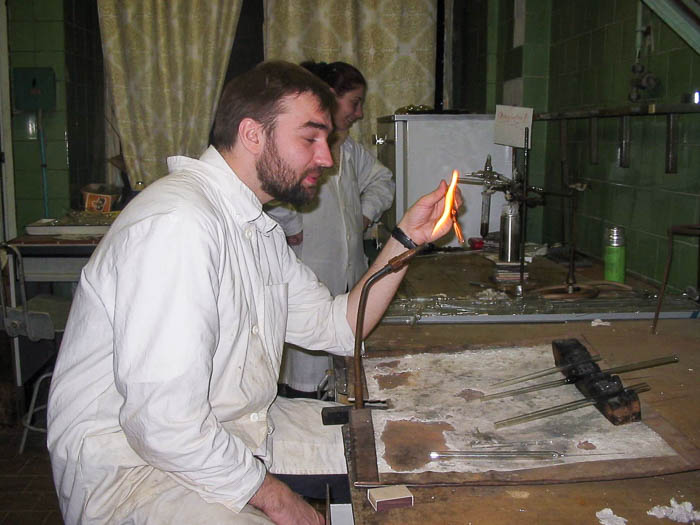Department of General and Inorganic Chemistry
Donor-Acceptor Interactions Research Group
Study of structures and reactivity of donor-acceptor compounds in condensed, liquid and gaseous phases.
Group leader Alexey Y. Timoshkin, Ph.D, Associate Professor,Acting head of the General and Inorganic Сhemistry department. E-mail: This email address is being protected from spambots. You need JavaScript enabled to view it.
Author and supervisor of online courses “Inorganic chemistry: Introduction to chemistry of the elements”
on Coursrera: https://www.coursera.org/learn/neorganicheskaya-khimiya/home/welcome
on Stepik: https://stepik.org/course/2542/syllabus
on NPOO: https://openedu.ru/course/spbu/CHEM/
and “Structure of matter: atoms, molecules, nanomaterials”
on Coursrera: https://www.coursera.org/learn/structure-of-matter-1/home/welcome
on NPOO: https://openedu.ru/course/spbu/CHEM2/
Part 1: https://openedu.ru/course/spbu/CHEM_ENG1/
Part 2 :https://openedu.ru/course/spbu/CHEM_ENG2/
Current research topics:
- Synthesis and characterization of donor-acceptor compounds by X-ray structural analysis, IR and NMR spectroscopy; study of their thermal stability and vaporization by tensimetry and mass-spectrometry methods; reactivity studies of complexes in non-aqueous solutions and in the gas phase.
- Quantum chemical computations of structural and thermodynamic characteristics of donor-acceptor complexes, studying of the reaction mechanisms.
- Development of structural-thermodynamic approach in high temperature chemistry of coordination compounds.
- Application of donor-acceptor compounds in catalysis, chemical vapor deposition and as precursors for the composite materials.
- Donor-acceptor stabilization of reactive inorganic hydrides and study of their decomposition mechanisms.
Group Members
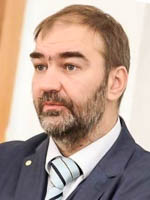 |
Group leader Alexey Y. Timoshkin, Ph.D. Associate Professor, (812) 428 40 71 This email address is being protected from spambots. You need JavaScript enabled to view it. |
Group members
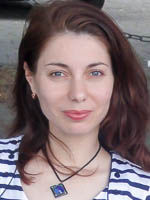 |
Davydova Elena I., Ph.D, Associate Professor Audience3149, 3151, 3153, 3156 (812) 428 40 71 This email address is being protected from spambots. You need JavaScript enabled to view it. |
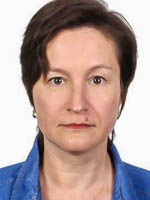 |
Pomogaeva Anna V., Ph.D, senior researcher Audience3156 (812) 428 40 71 |
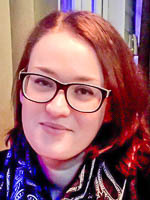 |
Lisovenko Anna S., Ph.D, senior researcher Audience3156 (812) 428 40 71 |
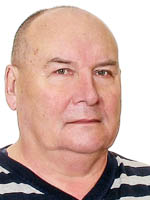 |
Kondrat’evYuriiV. D.Sc. Audience 113 (812) 428 40 71 |
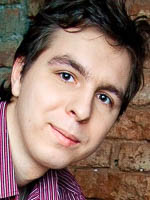 |
Kazakov Igor V., Ph.D, Associate Professor Audience 113, 3149, 3151, 3153, 3156 (812) 428 40 71 |
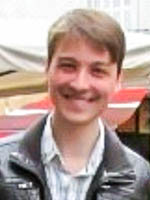 |
Doinikov Dmitriy A., researcher Audience 113, 3149, 3151, 3153, 3156 (812) 428 40 71 |
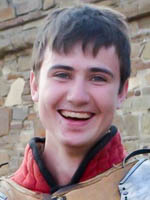 |
Zavgorodnii Artem S., teacher Audience 113, 3149, 3151, 3153, 3156 (812) 428 40 71 |
Students
|
Kulikova Yana I. Master student Audience 113, 3153 (812) 428 40 71 |
|
|
Shevchenko Anna V. Master student Audience 3149, 3151, 3153, 3156 (812) 428 40 71 This email address is being protected from spambots. You need JavaScript enabled to view it. |
|
|
AstahovEgor A., Bachelor student Audience 3149, 3151, 3153, 3156 (812) 428 40 71 |
|
|
Afanasiev Aleksey Y. Bachelor student Audience 3149, 3151, 3153, 3156 (812) 428 40 71 This email address is being protected from spambots. You need JavaScript enabled to view it. |
|
|
Vinogradova Maria A. Bachelor student Audience 3149, 3151, 3153, 3156 (812) 428 40 71 This email address is being protected from spambots. You need JavaScript enabled to view it. |
|
|
Kudina Polina I. Bachelor student Audience 3149, 3151, 3153, 3156 (812) 428 40 71 This email address is being protected from spambots. You need JavaScript enabled to view it. |
|
|
Glukhovich Ekaterina V. Bachelor student Audience 3149, 3151, 3153, 3156 (812) 428 40 71 |
|
|
Sharapova Dinara A. Bachelor student Audience 3149, 3151, 3153, 3156 (812) 428 40 71 |
|
|
Eliseev Alexey D. Bachelor student Audience 3149, 3151, 3153, 3156 (812) 428 40 71 |
Positions available
For participation in the post-position contest of St. Petersburg State University, contact the head of the research group A.Y. Timoshkin (E-mail: This email address is being protected from spambots. You need JavaScript enabled to view it.).
Partners
- Prof. M. Scheer (University of Regensburg),
- Prof. J. Beckmann (University of Bremen),
- Prof. F. Dielmann (University of Münster)
- Prof. G. Frenking (Philipps-Universität Marburg),
- Prof. J. Pinkas (University of Brno).
Current Research Topics
- Synthesis and characterization of donor-acceptor compounds by X-ray structural analysis, IR and NMR spectroscopy; study of their thermal stability and vaporization by tensimetry and mass-spectrometry methods; reactivity studies of complexes in non-aqueous solutions and in the gas phase.
- Quantum chemical computations of structural and thermodynamic characteristics of donor-acceptor complexes, studying of the reaction mechanisms.
- Development of structural-thermodynamic approach in high temperature chemistry of coordination compounds.
- Application of donor-acceptor compounds in catalysis, chemical vapor deposition and as precursors for the composite materials.
- Donor-acceptor stabilization of reactive inorganic hydrides and study of their decomposition mechanisms.
Grants, Scholarships and Awards
Research grants for the past 10 years:
- RSF Grant 23-13-00314 «Structure, stability and electronic structure of molecular complexes of halogens and diatomic interhalides with Lewis acids and bases», 2023-2025.
- RSF Grant № 23-23-00597 "Frustrated Lewis pairs on the basis of bidentate fragments", 2023-2024, (supervisorI.V.Kazakov).
- Joint grantRSF-DFG 21-43-04404 «Mixed main group element compounds of p block elements », 2021-2023.
- RSF Grant18-13-00196 «Acidity scales of Lewis acids and superacids», 2018-2020; 2021-2022 (extention).
- GrantSPSU-DFG «Donor-stabilized monomeric pnictidoalanes and gallanes», 2017-2019.(12.65.44.2017)
- RSF Grant 14-13-00151 «Amidoboranes of main group metals: thermal stability and decomposition mechanisms», 2014-2016. (12.53.1173.2014)
- SPSU Grant «Reactivity of group 13-15 inorganic heterocycles», 2014-2016. (12.38.255.2014)
Scholarships and Awards
- Alexey Timoshkin – Laureate of the St Petersburg University Prize for Scientific Works in the nomination Fundamental Achievements in Science, 2020.
- Artem Zavgorodnii - SPSU-DAAD scholarship “Dmitrij Mendeleev” 2018
- NadejdaScherbina, scholarship from the program of the association of graduates of SPSU 2021/2022.
- NadejdaScherbina, The winner of the competitive selection of applicants for the appointment of scholarships of the President of the Russian Federation 2021/2022
- NadejdaScherbina, The winner of the competitive selection of applicants for the appointment of scholarships of the Government of the Russian Federation 2021/2022.
- Tatiana Parfenuk, The winner of the competitive selection of applicants for the appointment of scholarships of the Government of the Russian Federation 2021/2022.
- NadejdaScherbina, Diploma for the best presentation at International Student Conference Science&Progress 2021 November 9-11, 2021.
Publications
Representative publications
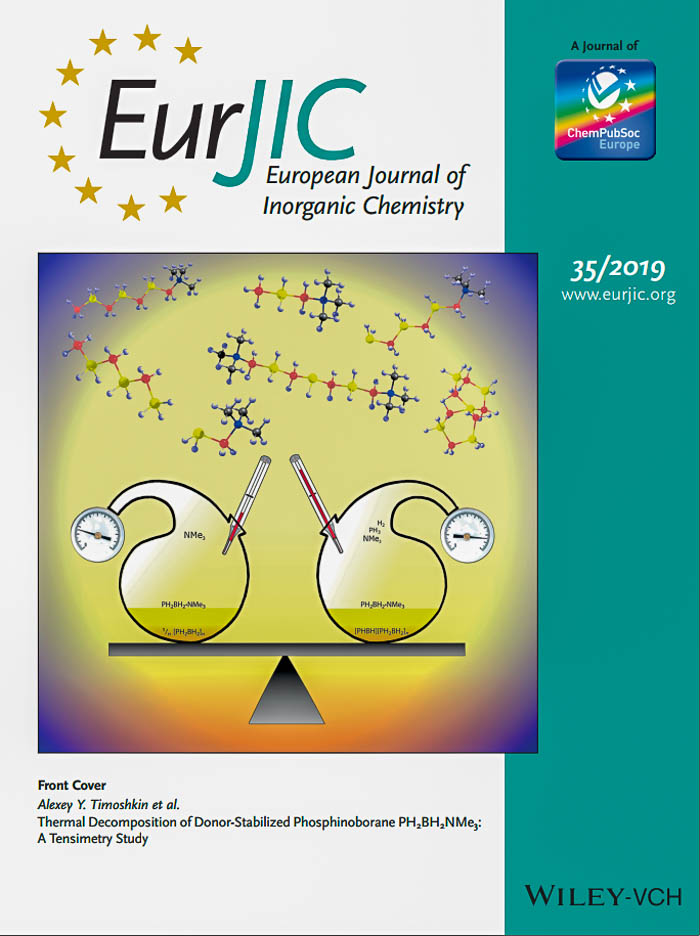 A. V. Butlak, I. V. Kazakov, A. Stauber, O. Hegen, M. Scheer, A. V. Pomogaeva, A. Y. Timoshkin Thermal decomposition of donor-stabilized phosphinoborane PH2BH2NMe3: a tensimetry study Eur. J. Inorg. Chem. 2019, N. 35, P. 3885-3891. DOI: 10.1002/ejic.201900817
A. V. Butlak, I. V. Kazakov, A. Stauber, O. Hegen, M. Scheer, A. V. Pomogaeva, A. Y. Timoshkin Thermal decomposition of donor-stabilized phosphinoborane PH2BH2NMe3: a tensimetry study Eur. J. Inorg. Chem. 2019, N. 35, P. 3885-3891. DOI: 10.1002/ejic.201900817
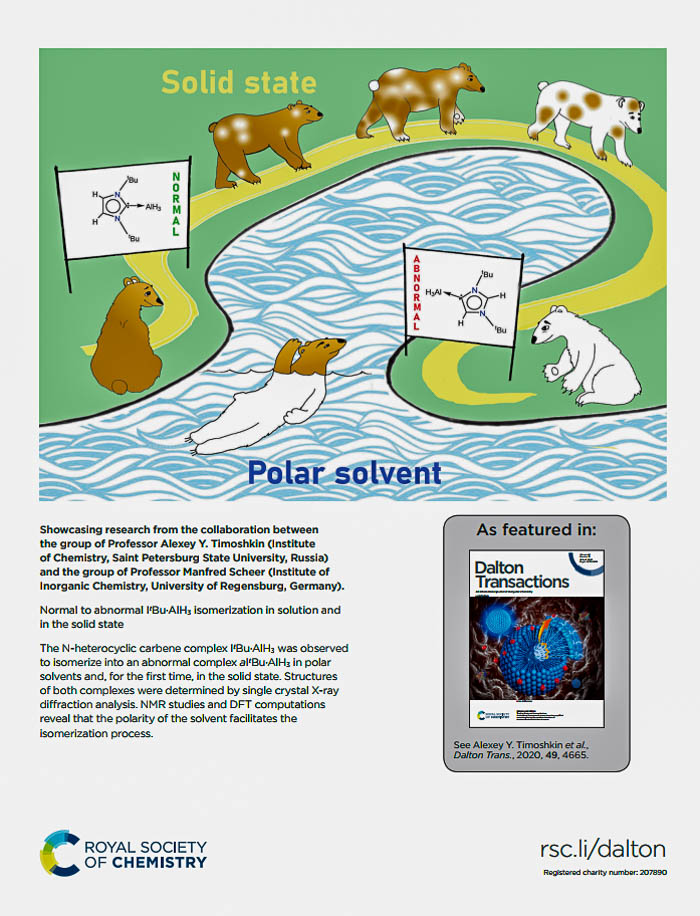 A.M. Chernysheva, M. Weinhart, M. Scheer, A. Y. Timoshkin Normal to abnormal ItBu•AlH3 isomerization in solution and in the solid state. Dalton Trans., 2020, Vol. 49, N. 15, P. 4665-4668. DOI: 10.1039/C9DT04698D
A.M. Chernysheva, M. Weinhart, M. Scheer, A. Y. Timoshkin Normal to abnormal ItBu•AlH3 isomerization in solution and in the solid state. Dalton Trans., 2020, Vol. 49, N. 15, P. 4665-4668. DOI: 10.1039/C9DT04698D
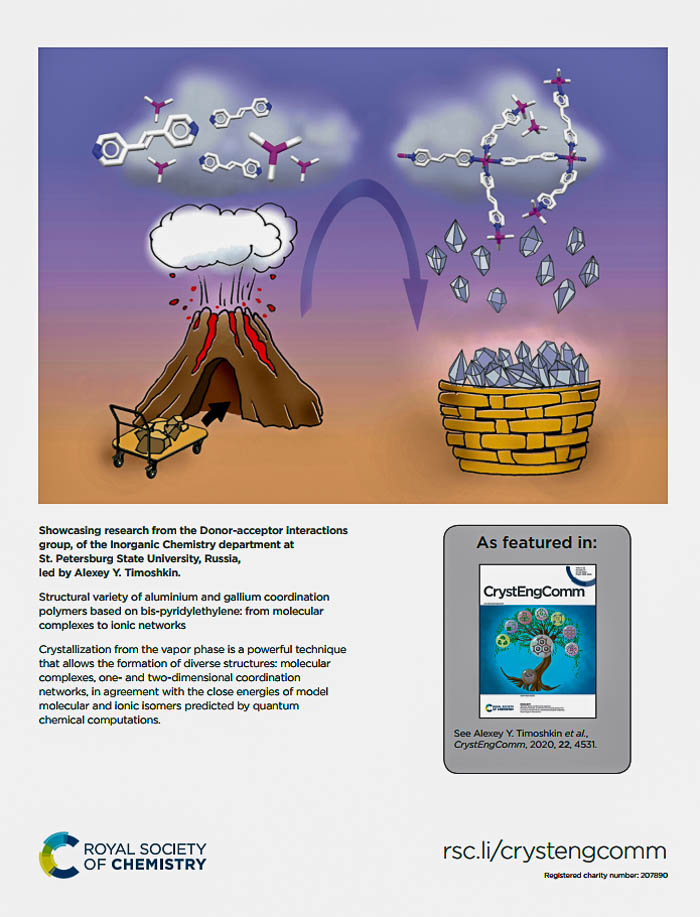 N. Y. Gugin, A. Virovets, E. Peresypkina, E. I. Davydova, A. Y. Timoshkin Structural Variety of Aluminium and Gallium Coordination Polymers Based on Bis-pyridylethylene: From Molecular Complexes to Ionic Networks. CrystEngComm, 2020, Vol. 22, N. 27, P. 4531–4543. DOI: 10.1039/D0CE00541J
N. Y. Gugin, A. Virovets, E. Peresypkina, E. I. Davydova, A. Y. Timoshkin Structural Variety of Aluminium and Gallium Coordination Polymers Based on Bis-pyridylethylene: From Molecular Complexes to Ionic Networks. CrystEngComm, 2020, Vol. 22, N. 27, P. 4531–4543. DOI: 10.1039/D0CE00541J
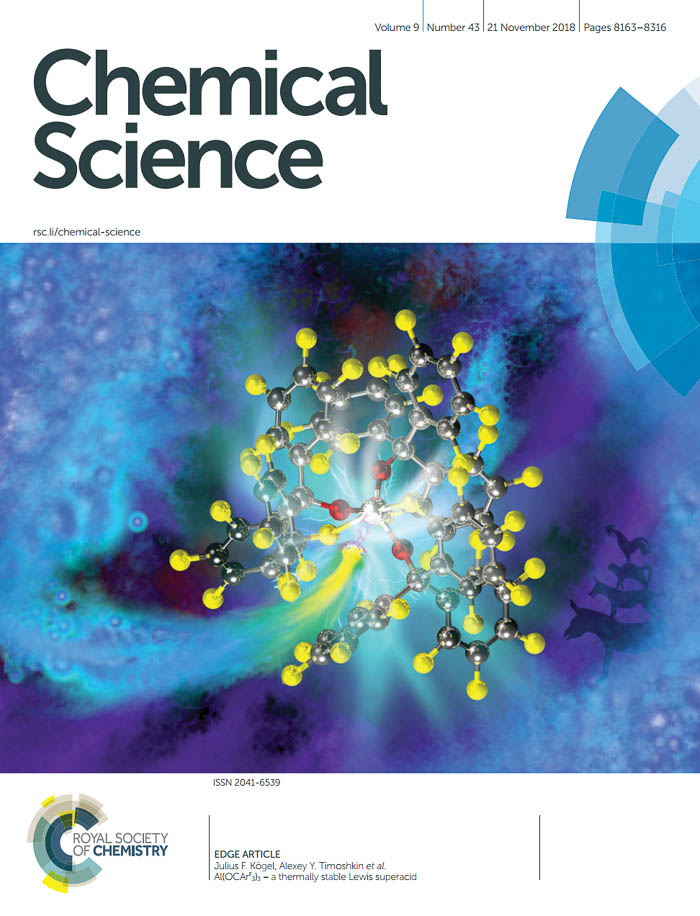 EDGE ARTICLE : J. F. Kögel, A. Y. Timoshkin, A. Schröder, E. Lork, J. Beckmann, Al(OCArF3)3 — A Thermally Stable Lewis Superacid. // Chem . Sci ., 2018, 9, N. 43, 8178-8183. doi.org/10.1039/c8sc02981d
EDGE ARTICLE : J. F. Kögel, A. Y. Timoshkin, A. Schröder, E. Lork, J. Beckmann, Al(OCArF3)3 — A Thermally Stable Lewis Superacid. // Chem . Sci ., 2018, 9, N. 43, 8178-8183. doi.org/10.1039/c8sc02981d
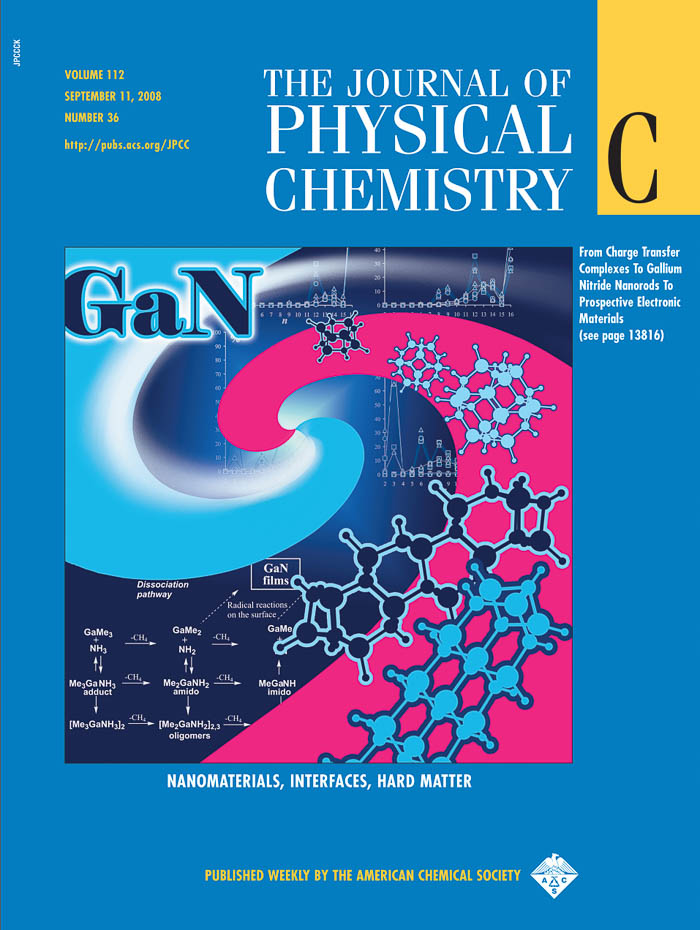 CENTENNIAL FEATURE ARTICLE: Timoshkin A.Y., Schaefer H.F. From Charge Transfer Complexes to Nanorods. // J. Phys. Chem . C . 2008, Vol. 112, N. 36, P. 13816 - 13836. doi.org/10.1021/jp801609z
CENTENNIAL FEATURE ARTICLE: Timoshkin A.Y., Schaefer H.F. From Charge Transfer Complexes to Nanorods. // J. Phys. Chem . C . 2008, Vol. 112, N. 36, P. 13816 - 13836. doi.org/10.1021/jp801609z
REVIEWS:
- A. Y. Timoshkin The Field Of Main Group Lewis Acids and Lewis Superacids: Important Basics and Recent Developments. Chem. Eur. J. 2024, 30, e202302457. https://doi.org/10.1002/chem.202302457
- Davydova E. I., Sevastianova T.N., Timoshkin A. Y. Molecular complexes of group 13 element trihalides, pentafluorophenyl derivatives and Lewis superacids. Coord. Chem. Rev., 2015, Vol. 297-298, P. 91-126. https://doi.org/10.1016/j.ccr.2015.02.019
- Davydova E.I., Sevastianova T.N., Suvorov A.V., Timoshkin A.Y. Molecular complexes formed by halides of group 4,5,13-15 elements and the thermodynamic characteristics of their vaporization and dissociation found by the static tensimetric method. // Coord. Chem. Rev.2010, Vol. 254, N. 17-18, P. 2031-2077. https://doi.org/10.1016/j.ccr.2010.04.001
- Timoshkin A.Y. Group 13 imido metallanes and their heavier analogs [RMYR’]n (M=Al,Ga,In; Y=N,P,As,Sb). // Coord. Chem. Rev.2005, Vol. 249, N. 19-20, P.2094-2131. https://doi.org/10.1016/j.ccr.2005.03.016
Key publications
Mück L.A., Timoshkin A.Y., von Hopffgarten M., Frenking G. Donor Acceptor Complexes of Noble Gases. // J. Am. Chem. Soc., 2009, Vol. 131, № 11, P. 3942–3949.http://dx.doi.org/10.1021/ja805990h
Timoshkin A.Y., Suvorov A.V., Bettinger H.F., Schaefer H.F. Role of the Terminal Atoms in the Donor-Acceptor Complexes MX3-D (M=Al,Ga,In; X=F,Cl,Br,I; D=YH3, YX3, X-; Y=N,P,As) // J. Am. Chem. Soc., 1999, V. 121, N. 24, P. 5687-5699.https://doi.org/10.1021/ja983408t
Timoshkin A.Y., Bettinger H.F., Schaefer H.F. // The Chemical Vapor Deposition of Aluminum Nitride: Unusual Cluster Formation in the Gas Phase. J. Am. Chem. Soc., 1997, V. 119, N. 24, P. 5668-5678. https://doi.org/10.1021/ja964163s
Representativepublicationsof the group for the past 10 years:
- Y. Timoshkin The Field Of Main Group Lewis Acids and Lewis Superacids: Important Basics and Recent Developments. Chem. Eur. J. 2024, 30, e202302457, https://doi.org/10.1002/chem.202302457
- V. Pomogaeva, A. S. Lisovenko, A. S. Zavgorodnii, A. Y. Timoshkin Lewis acid stabilized group 13-15 element analogs of ethylene. J. Comput. Chem., 2023, Vol. 44, N. 3, P. 218-228, https://doi.org/10.1002/jcc.26867
- V. Pomogaeva, A. Y. Timoshkin, Hydrogen activation by Frustrated and not so Frustrated Lewis pairs based on pyramidal Lewis acid 9-boratriptycene: a computational study. ACS Omega 2022, T 7, N. 51, 48493–48505. https://doi.org/10.1021/acsomega.2c06836
- N. Gugin, A. V. Virovets, E. V. Peresypkina, E. I. Davydova, A. Y. Timoshkin Coordination Polymers and molecular complexes of Group 13 Metal Halides with Bis-pyridylethane: comparison with rigid N-containing ligands. CrystEngComm, 2022, Vol. 24, N. 47, P. 8266-8278. https://doi.org/10.1039/D2CE01063A
- N. A. Shcherbina, I. V. Kazakov, A. S. Lisovenko, M. A. Kryukova, I. S. Krasnova, M. Bodensteiner, A. Y. Timoshkin Molecular complexes of non-chelating polydentate Lewis bases with group 13 Lewis acids: crystal structure and computed energy of stepwise donor–acceptor bond formation. Mendeleev Commun., 2022, 32, 74–77. https://doi.org/10.1016/j.mencom.2022.01.024
- E. I. Davydova, A. Virovets, E. Peresypkina, A. V. Pomogaeva, A. S. Lisovenko, A. Y. Timoshkin Unusual molecular complexes of antimony fluoride dimers with Acetonitrile and Pyridine: structures and bonding. Dalton Trans., 2021, Vol. 50, N. 38, P. 13357-13367. https://doi.org/10.1039/D1DT02412D
- N.A.Shcherbina, I. V.Kazakov, A.V.Pomogaeva, A. S.Lisovenko, M. A.Kryukova, D.A.Doinikov, N. Yu.Gugin, Y.V.Kondrat'ev, A.Y.Timoshkin Structures and thermal decomposition of complexes of E(C6F5)3 (E=Al, Ga, In) with pyridine. J. Organomet. Chem. 2021, Vol. 948, P. 121909.https://doi.org/10.1016/j.jorganchem.2021.121909
- V. Pomogaeva, A. Y. Timoshkin Influence of the solvent on the Lewis acidity of antimony pentahalides and group 13 Lewis acids toward acetonitrile and pyridine. J. Comput. Chem., 2021, Vol. 42, N. 25, P. 1792-1802. https://doi.org/10.1002/jcc.26713
- A. V. Butlak, I. V. Kazakov, A. Stauber, O. Hegen, M. Scheer, A. V. Pomogaeva, A. Y. Timoshkin Thermal decomposition of donor-stabilized phosphinoborane PH2BH2NMe3: a tensimetry study. Eur. J. Inorg. Chem. 2019, N. 35, P. 3885-3891. https://www.doi.org/10.1002/ejic.201900817
- A.M. Chernysheva, M. Weinhart, M. Scheer, A. Y. Timoshkin Normal to abnormal ItBu•AlH3 isomerization in solution and in the solid state. Dalton Trans., 2020, Vol. 49, N. 15, P. 4665-4668. https://www.doi.org/10.1039/C9DT04698D
- N. Y. Gugin, A. Virovets, E. Peresypkina, E. I. Davydova, A. Y. Timoshkin Structural Variety of Aluminium and Gallium Coordination Polymers Based on Bis-pyridylethylene: From Molecular Complexes to Ionic Networks. CrystEngComm, 2020, Vol. 22, N. 27, P. 4531–4543. https://www.doi.org/10.1039/D0CE00541J
- O. Hegen, J. Braese, A. Y. Timoshkin, M. Scheer, Bidentate Phosphanyl- and Arsanylboranes. Chem. Eur. J., 2019, Vol. 25, N. 2. P. 485-489. https://doi.org/10.1002/chem.201804772
- E. I. Davydova, A. Virovets, E. Peresypkina, A. V. Pomogaeva, A. Y. Timoshkin, Crystal Structures of Antimony(III) Chloride complexes with Pyridine. Polyhedron, 2019, Vol. 158, P. 97-101. https://doi.org/10.1016/j.poly.2018.10.056
- A. V. Pomogaeva, A. Y. Timoshkin, M. Scheer, Why do B-P and Al-P polymers differ? Structures, stability and electronic properties of chain and ring [H2PEH2]n oligomers (E = B, Al; n = 1-15). Chem. Eur. J., 2018, V. 24, N. 64, P. 17046-17054. https://doi.org/10.1002/chem.201803008
- O. Hegen, A. V. Virovets, A. Y. Timoshkin, M. Scheer, The Lewis base stabilized diphenylsubstitutedArsanylborane – A versatile building block for arsanylborane oligomers. Chem. Eur. J., 2018, V. 24, N. 62, P. 16521-16525. https://doi.org/10.1002/chem.201804341
- J. F. Kögel, A. Y. Timoshkin, A. Schröder, E. Lork, J. Beckmann, Al(OCArF3)3 - A Thermally Stable Lewis Superacid. Chem. Sci., 2018, 9, N. 43, 8178-8183. https://doi.org/10.1039/c8sc02981d
- J. Braese, A. Schinabeck, M. Bodensteiner, H. Yersin, A. Y. Timoshkin, M. Scheer, Gold(I) Complexes Containing Phosphanyl- and Arsanylborane Ligands. Chem. Eur. J., 2018, 24, 10073-10077. https://doi.org/10.1002/chem.201802682
- Kondrat'ev, Yu. V., Butlak, A. V., Kazakov, I. V., Krasnova, I. S., Chislov, M. V., Timoshkin, A. Yu., Heat Effects of the Thermal Decomposition of Amidoboranes of Potassium, Calcium, and Strontium, Russ. J. Phys. Chem. A 2018, Vol. 92, № 4, pp 640–645. http://dx.doi.org/10.1134/S0036024418040143
- S. Heinl, A. Y. Timoshkin, J. Müller, M. Scheer, Unexpected differences in the reactivity between the phosphorus and arsenic derivatives [(CpBIGFe)2(µ,η4:4-E4)] (E = P and As). Chem. Commun. 2018, Vol. 54, N. 18, P. 2244-2247. .https://doi.org/10.1039/c7cc09730a
- C. Marquardt, O. Hegen, A. Vogel, A. Stauber, M. Bodensteiner, A. Y. Timoshkin, M. Scheer, Depolymerization of Poly(phosphinoboranes): From Polymers to Lewis Base Stabilized Monomers. Chem. Eur. J. 2018, Vol. 24, N. 2, P. 360-363. https://doi.org/10.1002/chem.201705510
- Doinikov, D. A., Kazakov, I. V., Krasnova, I. S., Timoshkin, A. Yu., An automatic digital tensimeter with a membrane zero-manometer. Russ. J. Phys. Chem. A 2017, 91, 1603–1608. https://doi.org/10.1134/S0036024417080088
- Kazakov I.V., Butlak A.V., Shelyganov P.A., Suslonov V.V., Timoshkin A.Y. Reversible structural transformations of Rubidium and Cesium amidoboranes . Polyhedron, 2017, Vol. 127, P. 186-190. https://doi.org/10.1016/j.poly.2017.01.062
- O. Hegen, C. Marquardt, A. Y. Timoshkin, M. Scheer. A convenient Route to mixed Pnictogenylboranes. Angew. Chem. Int. Ed., 2017, Vol. 56, N. 41, p. 12783–12787. https://doi.org/10.1002/anie.201707436
- Pomogaeva A.V., Timoshkin A.Y. The effect of terminal substituents on the electronic properties of rod-shaped [HGaNH]n oligomers. Physical Chemistry Chemical Physics, 2016, Vol. 18, N. 29, P. 19859-19865. https://doi.org/10.1039/c6cp02576e
- El Hamdi M., Solà M., Poater J., Timoshkin A. Y. Complexes of adamantane-based group 13 Lewis acids and superacids: bonding analysis and thermodynamics of hydrogen splitting. J. Comput. Chem. 2016, Vol. 37, N. 15., P. 1355-1362. https://doi.org/10.1002/jcc.24328
- Pomogaeva A.V., Morokuma K, Timoshkin A.Y. Trimeric cluster of lithium amidoborane - the smallest unit for the modeling of hydrogen release mechanism. J. Comput. Chem., 2016, Vol. 37, N. 14, P. 1259-1264. https://doi.org/10.1002/jcc.24316
- Doinikov D.A., Kollhammerova I., Löbl J., Necas M., Timoshkin A.Y , Pinkas J. Alumazene adducts with acetonitrile: structure and thermal stability. J. Organomet. Chem. 2016, Vol. 809, P. 38-44. https://doi.org/10.1016/j.jorganchem.2016.02.039
- Kondrat’evYu.V, Butlak A.V., Kazakov I.V., Timoshkin A.Y. Sublimation and thermal decomposition of ammonia borane: competitive processes controlled by pressure. Therm. Acta, 2015, Vol. 622, P. 64-71. https://doi.org/10.1016/j.tca.2015.08.021
Equipment
Thermoscientific ISQ mass spectrometer with Direct Insertion Probe (DIP). The compact quadrupole mass spectrometer allows mass spectrometry studies of solid, liquid and gaseous samples. Transfer of solid and liquid samples into the gas phase is carried out using DIP with the implementation of programmable heating of the sample in the temperature range of 30–450 °C. Ionization is effected by electron impact with an electron energy of 70 eV. Data collection and analysis is carried out using the Thermo Scientific Xcalibur software package.
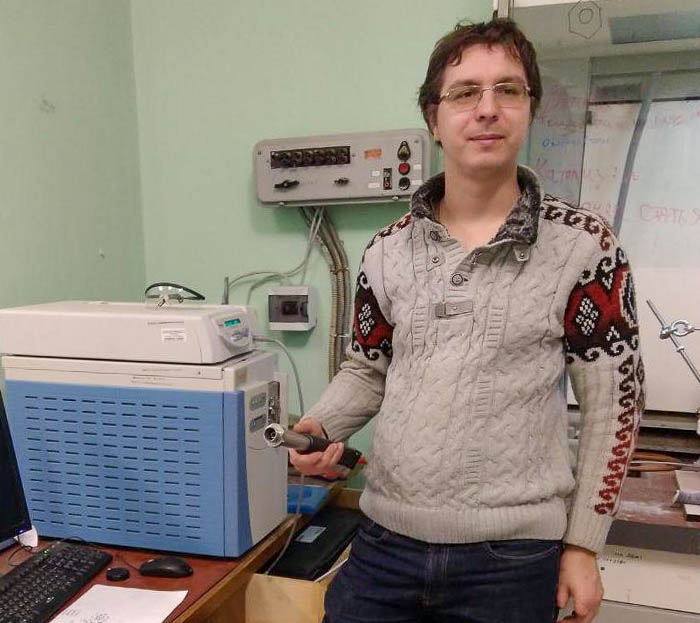
IR spectrometer Shimadzu IR Prestige-21. Allows measurement of the IR spectra of samples in the wavelength range of 250–7800 cm-1 with a resolution of 0.5–1 cm-1 and a signal-to-noise ratio of 40,000:1. IRsolution software is used to collect and analyze data.
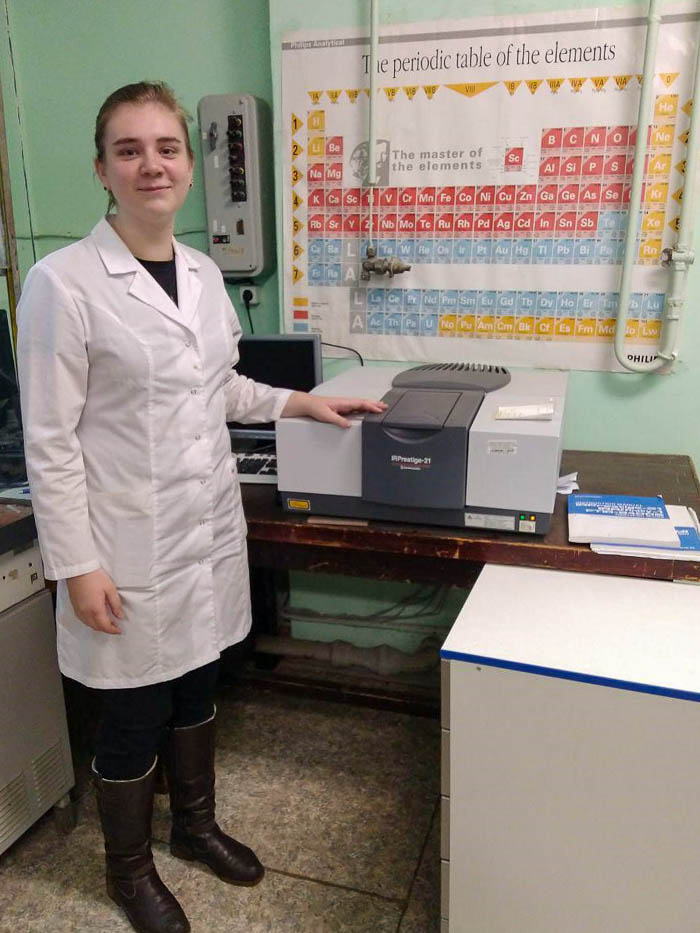
Automatic static tensimeter isuniquely designed to enable continuous and long-term measurement of pressure and temperature in a closed glass system. Currently, measurements are possible in the temperature range from -196 °C to 400 °C and pressures of 1–760 torr. The collection and primary analysis of data is carried out on the basis of the software developed in the laboratory based on the LabView programming language. Analysis of the results of the conducted research allows us to draw conclusions about the thermal stability of compounds, the thermodynamic characteristics of the processes of dissociation, sublimation and evaporation, and the kinetics of the processes.
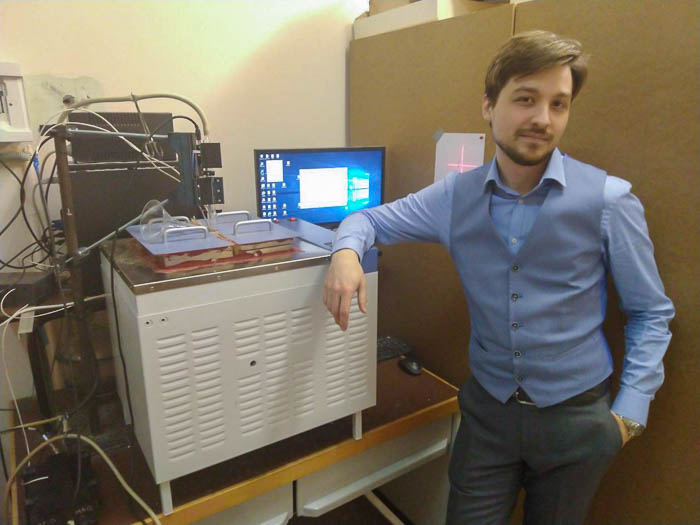
Differential automatic evaporation calorimeter DAK1-1a is used to directly determine the thermal effects of the processes of sublimation, evaporation and dissociation in the temperature range of 25–210 °C.
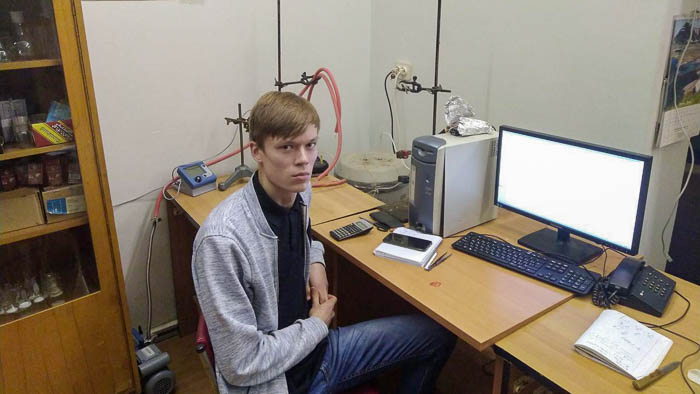
For work with compounds sensitive to moisture and oxygen, the laboratory is equipped with an InertLab 2GB glove box with an atmosphere of high-purity argon (residual moisture and oxygen content less than 0.1 ppm). The glove box is equipped with a freezer (up to -35 °C) and analytical balance, which allows for a full range of synthetic work and sample preparation for subsequent characterization. Schlenk lines are also used for work in an argon atmosphere.
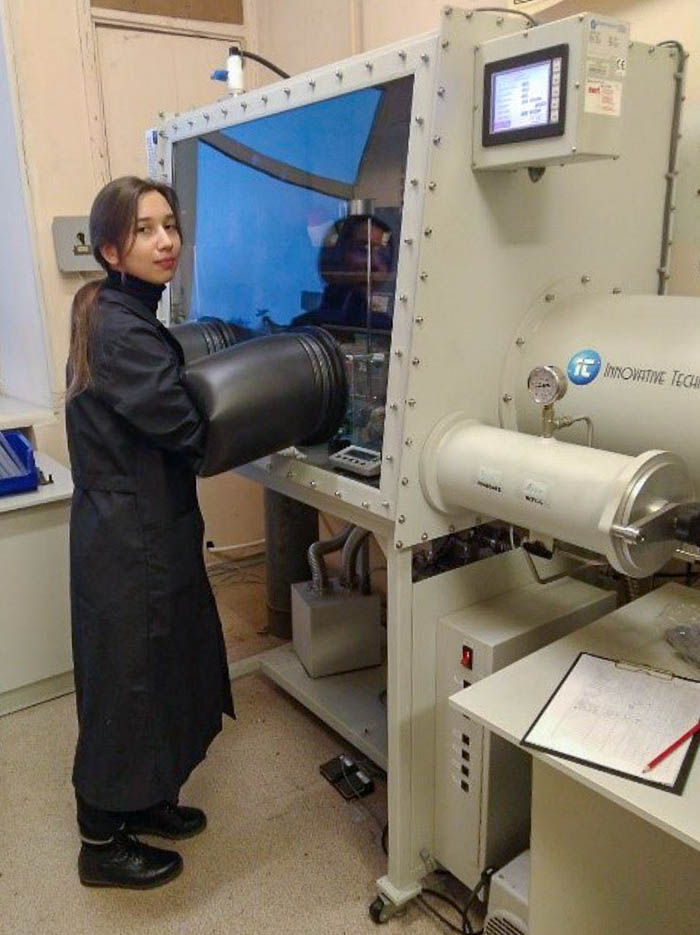
The laboratory has a glass-blowing workshop for the performance of synthetic works in wholeglass vacuumed systems.
